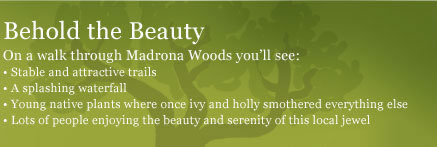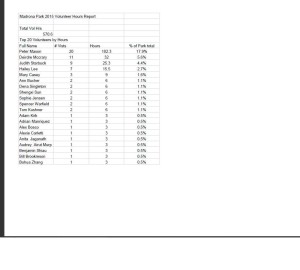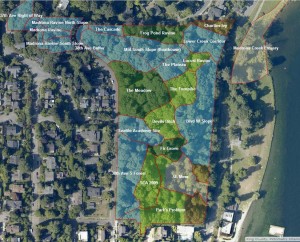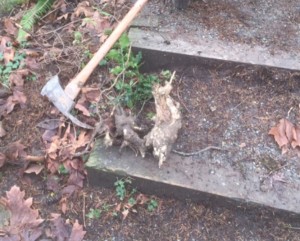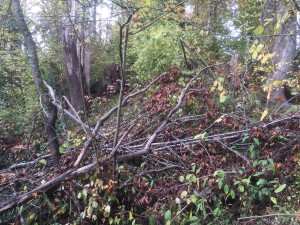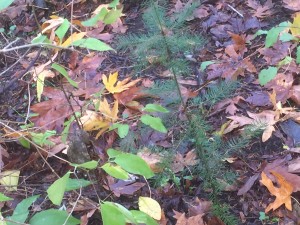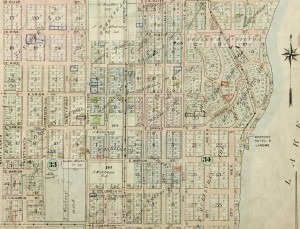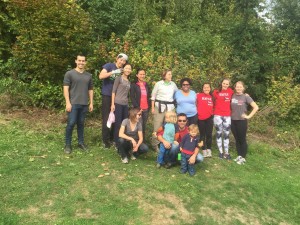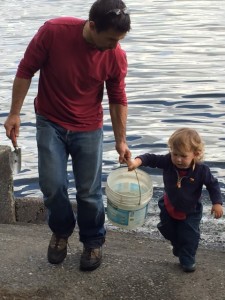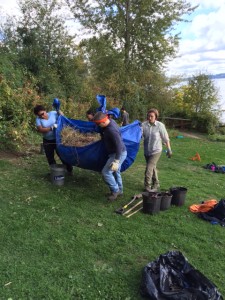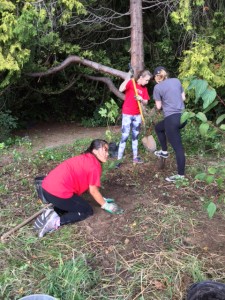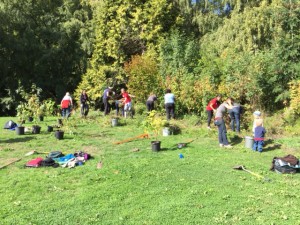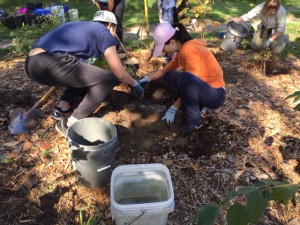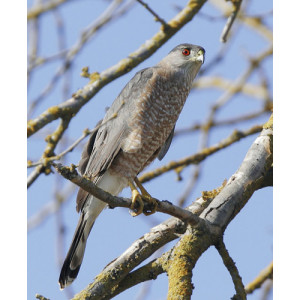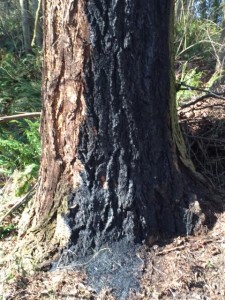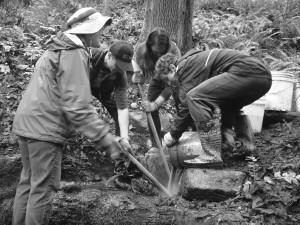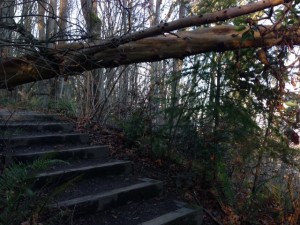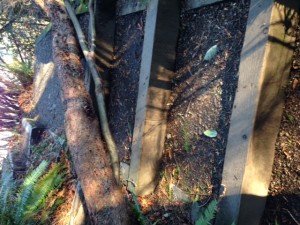
2015 Volunteer Hours Report
Filed under: Uncategorized
I had nothing to do on a rainy afternoon so I wrote some code to massage the massive spreadsheets produced by the Green Seattle Partnership’s Cedar system, where all our volunteer hours and work logs are supposedly entered. I had been suggesting all kinds of fixes to Cedar, and sounding like a real complainer. So why not actually prototype something as a suggestion? The picture below is a screen-shot from the resulting pdf file. The system I set up can produce this summary for any of the hundred (or so) parks and natural areas that the GSP manages.
Cool GIS Map of our Park
The Green Seattle Partnership has worked to track restoration all over Seattle. This is encapsulated in an online map, where you can search for a park (like Madrona Park, or Lakeridge Park), or just zoom and browse. You can click on ecological regions within a park, and find all kinds of data like acreage, phase (restoration progrees), target forest type (plant ecosystem), and steepness of slope. Believe me, the steepness matters. Click here for the city-wide map. A version of the map of Madrona Woods is below.
Woods Workout with a Difference
Filed under: Uncategorized
Are you (like me) looking to burn off holiday pounds? Tired of the same old boring inside jazzercise, zumba, yoga, rumba, et cetera exercise? Does that person bossing you around while you exercise bother you?? We promise you a free range, full body, self-directed exercise experience.
For a limited time only, try the patented “Madrona Woods dig out holly stumps on slippery steep slopes” workout. This unique cross training solution features: digging, sawing, lopping, chopping, prying, pulling, and, if you’re like me, swearing. The small stumps in the picture took about 2 person-hours to remove from the steep clay slope. Want to join up? We are looking for a few good people. Check out our friendly work party events here. And if you only click, please like our facebook page here. This is a limited offer because at some point we are going to dig out all of these blasted stumps, and put ourselves out of business. I fervently hope!
Rebirth/Regeneration
Usually people, appropriately enough, write about rebirth in the spring. But restoration geeks sometimes think a bit backwards. Fall is the opposite of spring. We give damaged nature a helping hand by transplanting native plants into natural areas, and we do it in the fall to maximize survival rates. We have a fall planting event coming up in Madrona Woods on Sat Nov 28, from 10-1. Please join us.
Another way to think about rebirth is: “out with the old, in with the new.” The picture above shows recent large fallen branches from a 100 year old big leaf maple that is nearing the end of its lifespan.
This picture shows one of dozens of new Douglas fir trees that are regenerating (growing from seed) in Madrona Woods. They’re all in a relatively small spot where we cleared ivy in 2007. Their ancestor (150 ft tall or so) is nearby. In the last 10 years nearby trees and branches have fallen, creating a window of sunshine. This is a sign of a self-sustaining conifer forest, one of the primary goals in our project. When the deciduous, short lifespan maples and alders die, we want the long lifespan evergreen conifers to be able to succeed them and establish themselves as the biggest, baddest trees around.
Pre-Olmstead Plans for Madrona Woods
Filed under: Uncategorized
Thanks to Jennie Grant for sending me this 1905 map that shows 38th Ave, 39th Ave, and Marion St all cutting directly across what is now Madrona Woods. Plus there is an alley between 38th and 39th. Building these roads would have taken a lot of construction! I think we can probably all agree we’re glad this plan was never implemented.
Lakeside Work Party on a Beautiful Early Fall Day
Filed under: Uncategorized
On Sept 26, the people in these pictures spent a beautiful morning helping us. They planted 30 really big shrubs. They hauled about 500 lbs of water up from the lake to water the plants. They cleared 500 sq ft of blackberry and other invasive plants. They hauled the pulled invasive plants 200 yards to our big pile. They are pictured here next to Lake Washington, looking at an awesome view of Mt Rainier.
Cooper’s Hawks in Madrona Woods and Seattle
Filed under: Uncategorized
Madrona Woods has been home to a successful nesting pair of Cooper’s hawks for several years. They have fledged 5 young. They nest in the ravine above the haipin turn, where there are no trails. It turns out that there are lots of these hawks nesting in Seattle. See this report for details.
Fire Quickly Extinguished in Madrona Woods
Filed under: Uncategorized
On Sunday March 1, a big Douglas Fir in Madrona Woods got a hot foot! It ended up charred about 20 ft up above ground level. Thanks to the Seattle Fire Department for putting out the fire! Thanks also to the person(s) who reported this fire to 911 – they most likely also waited for the fire department to show up and told them the tale. Otherwise how could the Fire Dept have found the blaze 100 yds into the woods?
Our Little Creek with a Mind of Its Own
Filed under: Uncategorized
by Judith Starbuck, Grand Avenue, interview with Peggy Gaynor, Gaynor, Inc.
Our Madrona Woods restoration group hopes you’re enjoying the Madrona Creek as much as we are. I especially love the sound of it from the bridges. Landscape architect Peggy Gaynor is the mastermind behind the Madrona Woods restoration, and in particular the daylighting of Madrona Creek. Our January work party included repair to that creek, with Peggy’s guidance on patching and shoring up places where the water was going where it wasn’t intended to. Here are some of Peggy’s thoughts on creek maintenance.
JS: Did you foresee how many times our group would need to bring the creek back into its constructed banks when it had either gone off to the side or into a hole?
PG: No. We have discovered a lot of concrete debris that was dumped in the ravine where the creek flows. The dumping was done back in the days when environmental concerns were not on the radar. This has created voids under the surface, and water has a way of finding the path of least resistance—these voids in this case. A number of times the water has seemed to disappear into a hole, and we’ve had to patch the stream bed to get it back on course at the surface. We don’t want the stream to continue underground and possibly undermine Lake Washington Boulevard. We use a natural clay called Bentonite, which expands when mixed with water and seals off these areas like the caulk in a bathtub. First filling the void with mud and gravel, then a mix of Bentonite and sand topped with a protective layer of rocks and gravel plugs the “leaks,” but some have required more than one fix.
JS: How does our creek compare with other daylighted creeks you’ve worked on?
PG: This creek daylighting was more challenging due to elevation change (over 750 feet elevation gain from Lake to headwaters) and the unknown soil/landfill issues along the creek corridor mentioned above. So far this is the only daylighted stream that goes from its headwaters in springs in the hillside between 37th and 38th streets into the lake. Though the distance is short, just over a quarter of a mile, it’s providing fresh water and nutrients for salmon migrating along the shore of Lake Washington.
JS: How do you see creek maintenance in the future?
PG: Future maintenance should be more of a partnership between Seattle Parks and Friends of Madrona Woods, and it will likely involve some additional expertise and consultation for long-term solutions, especially for the “leaks” and sinkhole issues. Experts could include geotechs and even stone masons. It will still be up to Friends’ volunteers to keep watch on the creek and notice when it seems to be going astray and needs attention.
Two Fallen Sentinels
Last Thursday, Dec 11, we had a very big wind storm. The two big casualties in Madrona Woods were pacific madrones, aka arbutus menziesii. These are the “naming trees” for both our park and our neighborhood. Arbutus menziesii is a very distinctive Pacific Northwest native tree, found in coastal areas like the Magnolia bluffs, or anywhere in the San Juan islands. It is the only broadleaf evergreen tree native to the Pacific Northwest. We have only a few left in Madrona Woods, so losing two is quite a blow. Fortunately, some natural regeneration of madrones is taking place in the woods, thanks to all the clearing work we have done.
The larger of the two fell without completely being uprooted, and was left suspended over the trail. I was reluctant to chop this tree up, because it could have survived as it was. But safe and welcoming trails are a priority for us, so this tree had to go.
The smaller tree was less healthy, and was completely uprooted by the wind. Its position on the ground made it a bit more difficult to saw, due to “binding.”
The two madrones (18 inch diameter) fell across the top of the stairway in the woods. I set out this afternoon with a small bow saw, an axe, and a sledge. 4 hours later the trail was completely cleared. I was aided only by gravity. Gravity has often been my undoing, so it was nice to have its help.
In the course of my pleasant labor on a beautiful day, with a beautiful view, I met:
- A father and very young daughter. She was dressed as batgirl, complete with mask. They had already climbed the stairs (100 vertical ft). She climbed over the tree (not yet removed from the trail) quite cheerfully.
- An out of town visitor who was very happy to find a 10 acre well-maintained greenspace in the middle of urban Seattle.
- Another hiker who cheerfully offered to help me. This was early in the 4 hours – I might have taken him up on his offer during the last hour!
- A couple of dog walkers who controlled their dogs, who also hopped gracefully over the logs. Thanks to all dog owners who do the right thing.

